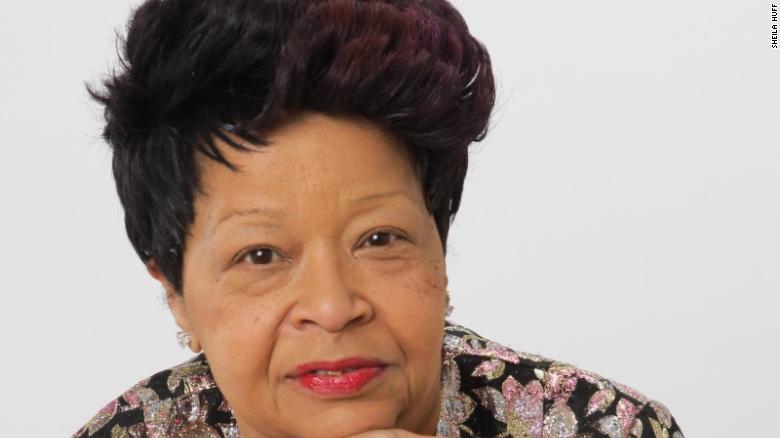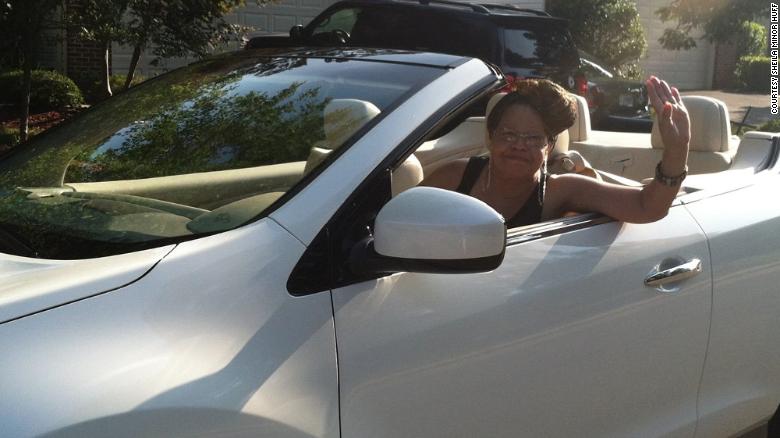Welcome to DU!
The truly grassroots left-of-center political community where regular people, not algorithms, drive the discussions and set the standards.
Join the community:
Create a free account
Support DU (and get rid of ads!):
Become a Star Member
Latest Breaking News
General Discussion
The DU Lounge
All Forums
Issue Forums
Culture Forums
Alliance Forums
Region Forums
Support Forums
Help & Search
The identity of the lone woman scientist in this 1971 photo was a mystery. Then Twitter cracked the


https://www.msnbc.com/stephanie-ruhle/watch/-goodnewsruhles-sheila-minor-huff-a-hidden-figure-no-more-1190507075910
CNN)Illustrator Candace Jean Andersen was doing some research for a children's book on orcas when she stumbled into a mystery. In an old article, she discovered a photo of scientists at the 1971 International Conference on the Biology of Whales in Virginia. And she noticed something: Amid the sea of male faces -- 37 of them -- was a lone woman, her face partially obscured.
The article named all the men, but the African-American woman was listed as "not identified."
"Not identified, why? Who is she? What did she contribute to the conference? What's HER story?" Andersen wondered. She put down her picture book project and started looking.
A global search
She tweeted: "Hey Twitter I'm on a mission: The woman in this photo was an attendee at a 1971 International Conference on Biology of Whales. She is the only woman, & the only one captioned 'not identified' in the article I found the photo in. All the men are named. Can you help me know her?" The identity of the lone woman scientist in this 1971 photo was a mystery. Then Twitter cracked the case. Andersen doesn't have a huge Twitter following, so she wasn't expecting much. But the tweet soon caught on and people all over the world joined the search.
After following a few false trails, social media detectives -- with help from an archivist at the Smithsonian -- were able to confirm within days that the woman was Sheila Minor Huff. At the time, she had been a biological specimen analyst at the Fish and Wildlife Service.
As it turns out, Huff went on to have a 35-year scientific career with the federal government and retired 12 years ago as a high-ranking environmental protection specialist.
Andersen tracked Huff down on Facebook and the women talked on the phone for almost an hour.
"She's very sweet. Humble, kind-hearted, positive. She didn't have a negative thing whatsoever to say," Andersen said.
. . . .
Huff, who's now 71, lives in Virginia. She wasn't aware of the social media search until Andersen contacted her. "I had to go to open a Twitter account to see what all the fuss was about," she told CNN. Huff said she never really worried about being identified, or recognized or celebrated, because she is passionate about natural resources and just wanted to get the job done.
"I do consider myself hidden because what's important is the outcome," she said.
Her work took her all over the country and she took on more and more responsibility as she rose through the ranks. At one point, she ran a Department of Interior office in Chicago and even got to drive one of the city's L subway trains when she was overseeing a project.
"They let me do that," she said with a laugh.
. . . .

https://www.cnn.com/2018/03/20/health/woman-scientist-1971-twitter-mystery-trnd/index.html
She Was the Only Woman in a Photo of 38 Scientists, and Now She’s Been Identified

. . . . . .
After she posted the photo, hundreds of people replied with comments and suggestions. The thread caught the attention of Margot Lee Shetterly, the author of the book “Hidden Figures: The American Dream and the Untold Story of the Black Women Mathematicians Who Helped Win the Space Race.” “Here’s a working scientist, contributing alongside her colleagues, and she’s not even given the professional courtesy of having her name recorded at a scientific conference,” Ms. Shetterly said on Sunday. “The photo, with her brown face half obscured by the people around her, is a perfect metaphor for the larger issue of history’s failure to record the work of women scientists, particularly women scientists of color.” Inspired by Ms. Andersen’s post, amateur researchers began combing through historical records and unearthing the names of women who worked in the sciences during the 1970s.
. . . . .
Then Dee Allen, the research program officer at the Marine Mammal Commission, saw the photograph on Twitter and contacted some of her mentors. “I figured it was probably something I could track down pretty easily, and I have an appreciation for the history of the field,” Ms. Allen said. She contacted Don Wilson, the emeritus curator of mammals at the Smithsonian National Museum of Natural History. Dr. Wilson remembered. He told Ms. Allen that the woman had worked as a museum technician, and her name was Sheila. “Sheila was working at the museum in the Division of Mammals when I first started there in September 1971,” Dr. Wilson said, adding that she was “an excellent technician.”
. . . .
The discovery was cheered by Ms. Andersen’s Twitter followers, and by Ms. Shetterly, who said it was “critically important” to tell the stories of people like Sheila who have historically been underrepresented, “as the leaky pipeline exists in the history of science and technology as well as in its present.” On Sunday, Sheila said her full name is Sheila Minor Huff. She is a retired, 71-year-old grandmother of five who belly dances, volunteers at her church and lives in Virginia.
Ms. Huff said she began working as an animal technician shortly after graduating with a bachelor’s degree in biology. When she applied for her first job at the Bureau of Sport Fisheries and Wildlife, she was asked to work as a typist. “I said, ‘No, I went to school too long to be your secretary!’” she recalled.
Ms. Huff said she went on to complete a master’s degree while working full time. She went to the Soviet Union to attend a conference for mammalogists. She worked with top government officials on a range of wildlife and environmental projects. By the time she retired, at 58, she had become a GS-14 federal employee — one of the highest designations possible — at the Department of the Interior. She said she was not too bothered about going unnamed in the 1971 snapshot. “It’s kind of like, no big deal,” she said. “When I try to do good, when I try and add back to this wonderful earth that we have, when I try to protect it, does it matter that anybody knows my name?”
https://www.nytimes.com/2018/03/19/us/twitter-mystery-photo.html
How Smithsonian Helped Solve the Twitter Mystery of the Unknown Woman Scientist
Sheila Minor was not, as some suggested, “support staff.” She was a biological research technician who went on to a 35-year-long scientific career
. . . . .
How Smithsonian Helped Solve the Twitter Mystery of the Unknown Woman Scientist
Sheila Minor was not, as some suggested, “support staff.” She was a biological research technician who went on to a 35-year-long scientific career
. . . .
Women of color amplified that message, and helped to narrow down the search, opening up a conversation on her race.* By Saturday, the post had gone viral, and Andersen had to turn the notifications off her phone. The search to identify “hidden figures”—a term popularized by the 2017 Oscar-nominated film and its book inspiration, about a team of black women mathematicians at NASA whose work was never recognized—has gained new attention in recent years. Efforts by historians, researchers and the general public have begun investigating the stories behind unsung women, particularly women of color, and writing their accomplishments back into the mainstream narrative.*
Andersen’s effort tapped into that energy, leading history enthusiasts, professional historians and archivists down the rabbit hole.* Perhaps, some suggested, she was Matilene Spencer Berryman, an oceanographer who was also an environmentalist and attorney, and who died in 2003. But others quickly pointed out that Berryman would have been in her early 50s when the photograph was taken, while the woman in question appeared to be much younger.
. . . .
How Smithsonian Helped Solve the Twitter Mystery of the Unknown Woman Scientist
Sheila Minor was not, as some suggested, “support staff.” She was a biological research technician who went on to a 35-year-long scientific career
Women of color amplified that message, and helped to narrow down the search, opening up a conversation on her race.* By Saturday, the post had gone viral, and Andersen had to turn the notifications off her phone. The search to identify “hidden figures”—a term popularized by the 2017 Oscar-nominated film and its book inspiration, about a team of black women mathematicians at NASA whose work was never recognized—has gained new attention in recent years. Efforts by historians, researchers and the general public have begun investigating the stories behind unsung women, particularly women of color, and writing their accomplishments back into the mainstream narrative.*
. . . .
Finally, users floated the name Sheila Minor (then Sheila Jones).
. . . .
By Sunday night, the thread had unearthed several social media profiles she thought might belong to the woman in question. Before she went to bed, Andersen reached out to the person she suspected to be Minor by Facebook. When she woke up, she had a message from Minor (who has since remarried, but has chosen to keep her current last name out of the public eye) waiting. It included an email address and the promise “We have so much to discuss.” “I thought, ‘Oh my gosh, she’s a living, breathing woman,‘” she says. “And she had responded with the heart eyes emoji and the ‘OMG’ so she’s got personality. She’s real.”
As Andersen waited to hear more, the Twitter thread caught the eye of Deborah Shapiro, a member of Smithsonian’s archive reference team, who flagged the potential Smithsonian connection. When she got into the office Monday, Shapiro found that Smithsonian’s own outreach team had also flagged the thread.“We haven’t had a viral thread come to us as long as I’ve been here,” Shapiro says. While the research and outreach teams have worked independently to unearth women affiliated with the Smithsonian who have been obscured from history, they also rely on the public for help. “We need outside researchers to come in and ask us questions to connect some of the dots for us,” she says, “because there are so many of these stories that have yet to be revealed.”
. . . .
Read more: https://www.smithsonianmag.com/smithsonian-institution/how-Smithsonian-helped-solve-mystery-unknown-female-scientist-1971-photo-180968518/#yoYZ9JO6P14qP2WZ.99
Give the gift of Smithsonian magazine for only $12! http://bit.ly/1cGUiGv
Follow us: @SmithsonianMag on Twitter
https://www.huffingtonpost.com/entry/twitter-found-the-name-and-history-of-this-trailblazing-black-female-scientist_us_5ab003b5e4b00549ac7e28f3
http://www.blackenterprise.com/black-woman-scientist-discovered-twitter/
InfoView thread info, including edit history
TrashPut this thread in your Trash Can (My DU » Trash Can)
BookmarkAdd this thread to your Bookmarks (My DU » Bookmarks)
5 replies, 1347 views
ShareGet links to this post and/or share on social media
AlertAlert this post for a rule violation
PowersThere are no powers you can use on this post
EditCannot edit other people's posts
ReplyReply to this post
EditCannot edit other people's posts
Rec (18)
ReplyReply to this post
5 replies
 = new reply since forum marked as read
Highlight:
NoneDon't highlight anything
5 newestHighlight 5 most recent replies
= new reply since forum marked as read
Highlight:
NoneDon't highlight anything
5 newestHighlight 5 most recent replies
The identity of the lone woman scientist in this 1971 photo was a mystery. Then Twitter cracked the (Original Post)
niyad
Mar 2018
OP
WheelWalker
(8,954 posts)1. Kick
shenmue
(38,506 posts)3. Applause
greatlaurel
(2,004 posts)4. Wow, great article
Thanks for the post!
Nitram
(22,776 posts)5. Great story. Thanks for posting it.